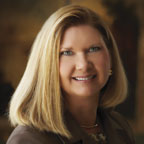Jan Wright, Publisher, The Peoria Woman

I find it curious that, even today—eight years into the 21st century—there is often more focus placed on a professional woman’s dress and hairstyle than on her leadership style and capabilities. And with a female candidate for president this year, the issue has climbed to the forefront like never before.
In December, an unflattering photo of Sen. Clinton was highlighted on the popular Drudge Report website, zooming in on every line and wrinkle on her face. To this, conservative radio host Rush Limbaugh posed the obnoxious question: “Will Americans want to watch a woman get older before their eyes on a daily basis?”
In the ‘80s, I entered the professional business world wearing traditional navy or black suits with shoulder pads, skirts at mid-knee length or longer, and white blouses with paisley “bowties.” Since then, office dress codes have relaxed, but even as a business owner, I felt a bit self-conscious the first time I wore summer sandals to work (with pantyhose, of course).
Recent trends toward “business casual” have altered the work uniform dramatically— permitting a change to pantsuits, throwing out the pantyhose, letting the hair down. Now, though, dress code policies have to be written and enforced for a new generation of women entering the workforce who never got the “soft skills” training they need. Even with a more permissive dress code, some must be told that it’s still not business-appropriate to wear spaghetti-strap tops, mini-skirts, flip-flops or similar “distracting clothes.”
A recent Wall Street Journal article stated, “Women in positions of authority…face fashion scrutiny that’s so intense it can border on comical—though it’s serious business to the women, their organizations and, it turns out, lots of working women…Female business leaders may play to a smaller audience, but the examination they face can be just as rigorous. According to unwritten rules, their appearance at work should be attractive but not alluring, feminine but not girly, strong but not severe.”
One psychology professor put together an interesting study on stereotyping. Participants were shown a video of one woman wearing a sexy, low-cut blouse with a tight skirt and another in a conservative skirt and blouse. The woman recited the same lines in both, and the viewer was told she was either a secretary or an executive. The more provocative dress had no effect on the perceived competence of the secretary, but it lowered the perceived competence of the executive dramatically.
Catalyst, a research group that studies women in the workplace, says that, 30 years after women entered the workforce in large numbers, the default mental image of a leader is still male. It seems women won’t be able to “win” until gender blinders are put on. Remember Katie Couric’s first appearance as a prime-time news anchor? Critiques of her legs, hair and dress were talked about more than her journalistic style. Perhaps that is why “pantsuits” have become the staple of an executive woman’s wardrobe. TPW
